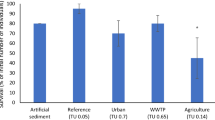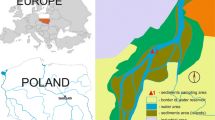Abstract
Biological impact assessment of sediment-bound contaminants is currently considered essential in addition to routine chemical characterization. Conventional methods of sediment bioassessment require relatively large quantities of the sample. When sample sizes are limited however, these methods become ineffective. To overcome this problem, the Limited Sample Bioassay (LSB) technique was developed. Bioassays conducted with bottom sediments and suspended particulates from western, central and Arctic regions of Canada indicated that the newly developed LSB technique successfully evaluated the contaminant/nutrient impact on laboratory-grown cultures of algae. The LSB method produced results which were comparable to those from standard elutriate bioassays conducted with natural phytoplankton size assemblages. The data suggest that the LSB can play an important role in providing a quick, simple, sensitive, and inexpensive screening technique for assessing the bioavailability of contaminants (or nutrients) from sediment of limited quantity.
Access this chapter
Tax calculation will be finalised at checkout
Purchases are for personal use only
Preview
Unable to display preview. Download preview PDF.
Similar content being viewed by others
References
Brannon, J. M. & R. M. Engler, 1977. Dredged material sample collection and preparation. In Ecological evaluation of proposed discharge of dredged material into ocean waters. Appendix B, U.S. E.P.A./U.S. Corps of Engineers, U.S. Army Corps, of Eng. Waterways Exp. Station, Vicksburg, Miss. 24 pp.
Daniels, S. A., M. Munawar & C. I. Mayfield, 1989. Sediment elutriation for testing the bioavailability of contaminants Hydrobiologia (in press).
Frank, R., G. J. Sirons, R. L. Thomas & K. McMillan, 1979. Triazine residues in suspended solids (1974–1976) and water (1977) from the mouths of Canadian streams flowing into the Great Lakes. J. Great Lakes Res. 5: 131–138.
Golterman, H. L., P. G. Sly & R. L. Thomas, 1983. Study of the relationship between water quality and sediment transport. A guide for the collection and interpretation of sediment quality data. U.N.E.S.C.O., Paris. 231 pp.
James, D. E., 1978. Culturing algae. Carolina Biological Supply Co., Burlington, North Carolina, 23 pp.
Leppard, G. G. & G. K. Burnison, 1983. Bioavailability, trace element associations with colloids and an emerging interest in colloidal organic fibrils. In G. G. Leppard (ed.), Trace Element Speciation in Surface Waters and its Ecological Implications. Plenum Publishing Corp.: 105–122.
Lind, O. T. & R. S. Campbell, 1969. Comments on the use of liquid scintillation for routine determination of 14C activity in production studies. Limnol. Oceanogr. 14: 787–789.
Munawar, M., A. Mudroch, I. F. Munawar & R. L. Thomas, 1983. The impact of sediment-associated contaminants from the Niagara River mouth on various size assemblages of phytoplankton. J. Great Lakes Res. 9: 303–313.
Munawar, M. & I. F. Munawar, 1987. Phytoplankton bio-assays for evaluating toxicity of in situ sediment contaminants. In R. L. Thomas, R. Evans, A. Hamilton, M. Munawar, T. Reynoldson & H. Sadar (eds), on Ecological Effects of In Situ Sediment Contaminants. Hydrobiologia 149: 87–105.
Munawar, M., W. P. Norwood, S. A. Daniels & L. H. McCarthy, 1986. Toxicological assessment of bottom and suspended sediments from Saskatchewan and the Arctic. A report submitted to the Water Quality Branch, Environment Canada, Western and Northern Region, Regina, Saskatchewan, 32 pp.
National Water Quality Laboratory, 1985. Manual of Analytical Methods. Inland Waters Directorate, Environment Canada, Canada Centre for Inland Waters, Burlington, Ontario.
Ongley, E. D. & D. P. Blatchford, 1982. Application of continuous flow centrifugation to contaminant analysis of suspended sediment in fluvial systems. Envir. Techn. Letters 3: 219–228.
Author information
Authors and Affiliations
Editor information
Editors and Affiliations
Rights and permissions
Copyright information
© 1989 Kluwer Academic Publishers
About this paper
Cite this paper
Munawar, M., Gregor, D., Daniels, S.A., Norwood, W.P. (1989). A sensitive screening bioassay technique for the toxicological assessment of small quantities of contaminated bottom or suspended sediments. In: Sly, P.G., Hart, B.T. (eds) Sediment/Water Interactions. Developments in Hydrobiology, vol 50. Springer, Dordrecht. https://doi.org/10.1007/978-94-009-2376-8_48
Download citation
DOI: https://doi.org/10.1007/978-94-009-2376-8_48
Publisher Name: Springer, Dordrecht
Print ISBN: 978-94-010-9007-0
Online ISBN: 978-94-009-2376-8
eBook Packages: Springer Book Archive




